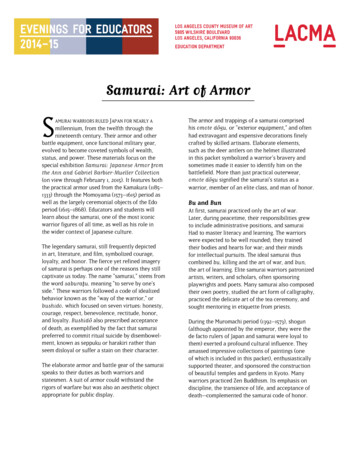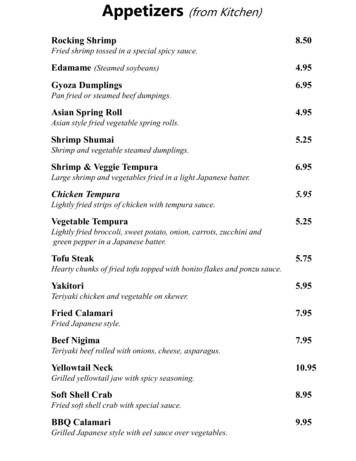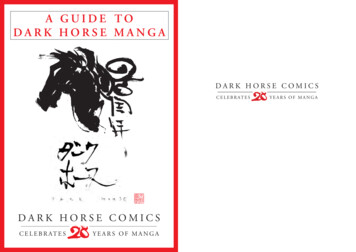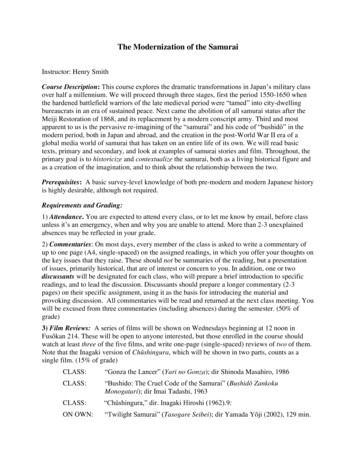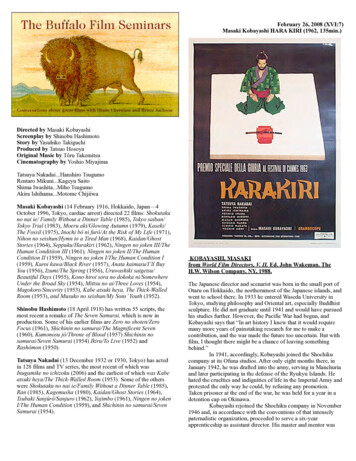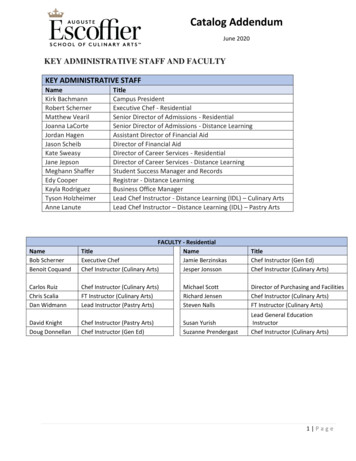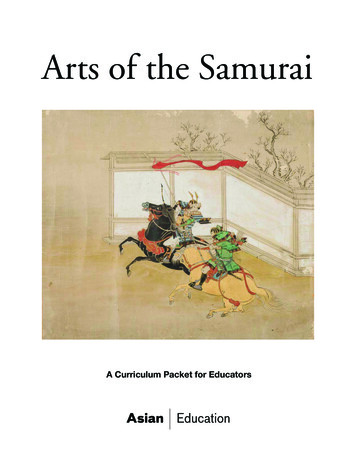
Transcription
Arts of the SamuraiA Curriculum Packet for Educators
Project Manager and “Notes to the Reader”:Stephanie Kao, Manager of School and Teacher Programs, Asian Art MuseumHistorical Overview, Image Descriptions, and Glossary:Laura W. Allen, Ph.D., Independent ScholarSuggested Lesson Plans and Activities:Lessons 1–6:Caren Gutierrez, School Programs Coordinator, Asian Art Museum; and Marilyn MacGregor,Educational Consultant, ArtSmartTalkLesson 7–9:Lucy Arai, Artist and Museum Education ConsultantFurther Reading and Video Bibliography:Mamiko Nakamura, Librarian, International Department, San Francisco Main Public Library; andLorraine Tuchfeld, Education Resource Coordinator, Asian Art MuseumDesigner:Jason Jose, Senior Graphics Designer, Asian Art MuseumEditor:Tisha Carper Long, Independent EditorWith the assistance of:Yoko Woodson, Ph.D., Curator of Japanese Art, Asian Art Museum; Forrest McGill, Ph.D., ChiefCurator and Wattis Curator of South and Southeast Asian Art, Asian Art Museum; andDeborah Clearwaters, Director of Education and Public Programs, Asian Art MuseumThe Education department would also like to extend our thanks to Kenneth Ikemoto, SchoolPrograms Associate; Cristina Lichauco, Assistant Registrar; Aino Tolme, Assistant Registrar/Photographic Services; and Jessica Kuhn, Digitization Project Assistant for their generous contributions to this packet.Copyright 2009 by the Asian Art Museum of San Francisco–Chong-Moon Lee Center for Asian Art and Culture, San Francisco.Cover art: Samurai in battle, detail of twelve battle scenes, 1600–1700. Japan. Edo period (1615–1868). Handscroll, ink and colors on paper.The Avery Brundage Collection, B60D90.2Asian Art Museum Education Department
Lead funding for the Asian Art Museum’s education programs and activities is provided by the Bank of America Foundation.Major support provided by the Koret Foundation, Freeman Foundation, Robert H. N. Ho Family Foundation, and Atsuhiko and Ina GoodwinTateuchi Foundation.Additional support provided by the William Randolph Hearst Foundation, Louise Rosenberg & Claude Rosenberg Jr. Family Foundation, Louise M.Davies Foundation, San Francisco Foundation, Mary M. Tanenbaum Fund, Robert and Helen Odell Fund, JPMorgan Chase Foundation, Joseph R.McMicking Foundation, Pacific Gas and Electric Company, Dodge & Cox, and Bingham McCutchen.Support for AsiaAlive is provided by the Walter & Elise Haas Fund.Asian Art Museum Education Department3
Table of ContentsINotes to the ReaderA. IntroductionB. Learning OutcomesC. The Age of the SamuraiD. The Geography of JapanIIHistorical OverviewA. The Growth and Development of a Military GovernmentB. Religious Practices of the Samurai: Pure Land and Zen BuddhismC. Warfare and ArmsD. Way of the WarriorE. Bu and Bun: The Arts of War and PeaceF. War TalesIIIImage DescriptionsIVSuggested Classroom Lesson Plans and ActivitiesA. How to Use this CurriculumB. Samurai as Loyal Warriors Lesson 1: Map Activity: Japan’s Warrior Government Lesson 2: The Code of the Samurai in Art and LiteratureC. Bu and Bun: Balancing Military Prowess and Artful Living Lesson 3: The History and Traditions of the Samurai Lesson 4: Samurai as Cultivators of the Arts: Waka Poetry, Noh Theater, and TeaD. Samurai as Spiritual Buddhist Lesson 5: The Spiritual Life of the Samurai Lesson 6: Calligraphy and Ink Painting: The Art of Ink and BrushE. Create Your Own Samurai Identity Lesson 7: Design Your Crest (Mon) Lesson 8: Samurai on the Battlefield Lesson 9: Samurai in Daily LifeVVIVIIVIIIIX4Content StandardsTimelineGlossaryFurther Reading and Video BibliographyCD of ImagesAsian Art Museum Education Department
Notes to the ReaderAsian Art Museum Education Department5
A. INTRODUCTIONThe legends of the Japanese warrior-statesmen, referred to as the samurai, are renowned for accountsof military valor and political intrigue—epic conflicts between powerful lords, samurai vassals, andthe imperial court—as well as accounts of profound self-sacrifice and loyalty. The term samurai isderived from the word saburau, or “one who serves.” The evolution of the samurai from mountedguards to the nobility (during the twelfth century) and their subsequent ascent to military leaders ofJapan (until imperial restoration during the nineteenth century) is chronicled in distinctive warriorarts and literary tradition. Their legacy has left enduring impressions on contemporary culture,influencing modern writers (such as Yukio Mishima) and filmmakers working in widely diversegenres (such as Akira Kurosawa, George Lucas, and Sergio Leone). The samurai have been comparedto the knights of Europe, and their moral philosophy of bushido has been likened to a code of chivalry. These simplifications, however, do not capture the social and cultural context within which thesamurai rose to prominence, and then held political authority in Japan for nearly seven hundredyears.The Asian Art Museum of San Francisco invites students to learn about the historical samuraithrough precious art objects from the museum’s collection. These include authentic military equipment (arms and armor), paintings depicting famed conflicts, ceremonial attire, and objects createdfor religious and cultural pursuits strongly connected with the samurai class.B. LEARNING OUTCOMESIn this educator packet students will: trace the origin and emergence of the samurai, Japan’s warrior class, from the medieval toearly modern period examine the concepts of cultural (bun) and martial (bu) arts, and how they exemplify thewarrior ideal explore the spread of Buddhism (Pure Land and Zen), cultural traditions (tea ceremony,paintings, ceramics, and dance), and technology (firearms) from nations overseas to theisland of Japan; and how these influences were shaped by the Japanese warrior to their needsand tastes analyze scenes from The Tales of the Heike and Chushingura, as depicted in screen paintingsand woodblock prints, and discuss how literature and its visual representation relate warriorvalues and codes of behavior investigate artworks from the Asian Art Museum’s collection: armor and weaponry, paintingsand traditional costumes, and ceramics and tea utensils; and examine how they reflect beliefsand daily life of the Japanese warrior C. THE AGE OF THE SAMURAIThe expression “Age of the Samurai” refers to the long period during which Japan was ruled byits warrior class. That age can be said to have begun with the establishment of a national militarygovernment at the end of the twelfth century. Prior to this period, local farms were owned by6Asian Art Museum Education Department
Samurai in battle, detail of twelve battle scenes, 1600–1700. Japan. Edo period (1615–1868). Handscroll, ink and colors on paper. The Avery BrundageCollection, B60D90J.absentee landlords—aristocrats and Buddhist monks—who lived in Kyoto, the imperial capital. Toensure their dominion over properties in remote regions, these owners employed bands of armedmen, each band having a leader; these were early models for daimyo and their samurai followers.Gradually these bands evolved into militias composed of vassals (samurai) acting in the service offeudal lords. Eventually one clan conquered all of its rivals and established Japan’s first nationalmilitary government, the Kamakura Shogunate, in 1185. From this date to the imperial restoration(the Meiji Restoration) in 1868, Japan was led by high-ranking samurai, referred to as daimyo, whogoverned regional domains from castles spread throughout the country (daimyo, means, roughly,“great landholder”). The daimyo were in turn subject to the authority of a primary lord known as theshogun. While the shogun professed allegiance to the emperor (presiding over the imperial court), inessence the emperor’s authority was cultural and ceremonial while the shogun exercised strict political control.During this time, samurai were expected to adhere to the ethical code of bushido, or the “Way ofthe Warrior.” Bushido—primarily an informal system of values subject to individual interpretationAsian Art Museum Education Department7
rather than an explicit set of written rules—advised warriors to live honorably by being mindfulof the nearness of death. The samurai prized values such as honesty, courage, respect, self-sacrifice,self-control, compliance with duty, and loyalty. These qualities were highly regarded for promotingmartial discipline and military efficiency. Over time, the samurai refined this code to more explicitlyencompass their leadership roles and their corresponding civil responsibilities. In its later forms,bushido was thought to bring stability to social organization.In all contexts, the essence of the samurai code lay in the concepts of bun and bu, or culture andmartial. In their personal behavior, in society, and in politics, warriors were expected to balance theirexpression of these two ideas. For the individual, martial prowess was not to take the form of unbridled aggression, and civil deference was not to give way to weakness. At the level of society, politicalforce was to be moderated with cultural activities, but force was always available to defend culture. Asamurai scholar of the eighteenth century compared bun and bu to the wings of a bird, writing:Culture and arms are like the two wings of a bird. Just as it is impossible to fly with onewing missing, if you have culture but no arms, people will slight you without fear, while ifyou have arms but no culture, people will be alienated by fear. Therefore, when you learn topractice both culture and arms, you demonstrate both intimidation and generosity, so peopleare friendly but also intimidated, and they will be obedient.Political rule by the samurai class continued into the second half of the nineteenth century, whena series of reforms known as the Meiji Restoration (beginning in 1868) changed the way Japan wasgoverned. Military domains were converted by newly appointed (later elected) governors into civilprefectures that remained at peace with one another. The Meiji Restoration marked the end of theAge of the Samurai.D. THE GEOGRAPHY OF JAPANPart of a long archipelago off the eastern rim of the Asian continent, the island country of Japan hasfour main islands: Hokkaido, Honshu, Shikoku and Kyushu. Numerous smaller islands lie on eitherends to form a sweeping arc formation that extends northeast to southwest. Japan’s closest neighborsare Korea and China. In Japan’s early history, the Korean Peninsula was used by travelers as a landlink between Japan and the vast expanse of China. A distinctive feature of the Japanese landscapeis its volcanic, mountainous terrain. More than two thirds of the land is adorned with low to steepmountains traversed by swift-flowing rivers. This unique topography contributes to a striking contrast in climate between the western coast, along the Sea of Japan, and the eastern coast, along thePacific Ocean. The dramatic geographic features of their country have instilled in the Japanese anenduring reverence for nature, and have shaped its political history and artistic culture.8Asian Art Museum Education Department
AmurR U S S I AAmurSakhalin IslandC H I N AHokkaidoS e aNORTH KOREAo fJ a p a nPyongyangSeoulSOUTHKOREAJAPANHonshuYellow SeaTokyoMount FujiKyotoHimejiOsakaShikokuKyushuE a s tC h i n aS e aRyukyu IslandsOkinawaAsian Art Museum Education DepartmentP a c i f i cO c e a n9
Historical Overview10Asian Art Museum Education Department
Samurai in battle, detail of twelve battle scenes, 1600–1700. Japan. Edo period (1615–1868). Handscroll, ink and colors on paper. The Avery BrundageCollection, B60D90.He carries himself with unshakable self-confidence, and is virtually unbeatable, a devastating duelist with superbly pure technique and a blinding-fast draw. Jin keeps firm controlof himself in every possible aspect from his appearance and appetite to his level monotonevoice [he] possesses a core of deep calm, but he’s a creature of fierce pride and intensitywho typically kills with a single stroke. At his darkest he radiates bitter, repressed anger, andobserves the world with a narrow, resentful stare; at his best, he’s all a samurai should be,capable of great gentleness, courtesy, martial skill and dauntless courage.—description of Jin, in Samurai Champloo, an animated TV series1Jin is a prime example of the “noble samurai,” a character type that recurs in countless manga (comics and graphic novels) and anime (animated films and TV shows) stories produced in Japan eachyear. Many of these products of modern popular culture draw inspiration from the lives of samurai,Japan’s traditional warriors, whose military leaders ruled Japan from the late 1100s until the lateAsian Art Museum Education Department11
1800s. As they flow into the West, Japanese manga and animated tales of martial prowess offeryoung people outside of Japan a powerful source of information about samurai—their military skills,values, even their physical appearance. But how well does this picture of the Japanese warrior matchwhat we know from historical sources? Are descriptions like that of the “duelist” Jin accurate, or arethey incomplete? How did the role of the samurai change and develop through history? What kindof religious practices did they favor? Other than swordsmanship, what other military skills or equipment did the samurai employ? And finally, beyond their prowess as fighters, what cultural abilitiesdid they possess? Answers to these questions may be found in the pages that follow.A. THE GROWTH AND DEVELOPMENT OF MILITARY GOVERNMENT2Origins of the SamuraiAlthough an emperor has reigned in Japan since ancient times, by the late 1100s powerful militaryleaders were challenging the power of the imperial court. From the thirteenth century on, Japanwas ruled through a dual government structure. While the emperor retained cultural and religioussovereignty over the nation, the military elite during this period assumed political and economicleadership. This system of governance remained in place until the late 1800s.Samurai (lit. “one who serves”) is the term used to refer to members of Japan’s warrior class.The origins of the samurai can be traced to the eighth and ninth centuries, when large landholdingsmoved into the hands of the imperial family and related members of the aristocracy (nobles). In theHeian period (794–1185), the Kyoto-based imperial court and nobles depended on the agriculturalincome from these landholdings, especially large private estates in northern Japan. The need todefend these distant estates from attacks by local chieftains led to the birth of the samurai. Thenobles sent from the capital to govern the estates often lacked the skills and authority necessary tomaintain security or provide effective administration in such remote districts, so the court appointeddeputies from among the local population to assist them. Forerunners of the early samurai, thesedeputies built local and regional power by creating privately controlled militia known as “warriorbands.”Starting as little more than family organizations, warrior bands were initially formed for theduration of a specific military campaign and then disbanded to allow the men to return to farming. By the eleventh century the bands were changing to groups of fighting men not necessarilyconnected through kinship. Power was beginning to aggregate in the hands of a few elite militaryfamilies, or clans, whose regional dominance was supported by the fighting abilities of retainers andvassals. These were men bound to their lords by vows of loyalty and/or other contractual obligations,such as grants of land or income in exchange for military service.The First Warrior Government: The Kamakura Shogunate, 1185–1333By the late eleventh century, the Minamoto (also known as Genji) clan was recognized as the mostpowerful military clan in the northeastern region of Japan, having defeated several other powerfullocal groups. In the mid-twelfth century, the Minamoto clashed with the mighty Taira (also knownas Heike) clan, which commanded an important western region including the area around Kyoto. Aseries of clashes, culminating in the Genpei War (1180–1185), ended with the defeat of the Taira.12Asian Art Museum Education Department
The victorious Minamoto went on toestablish a new, warrior-led government atKamakura, their eastern stronghold.In 1185 the great Minamoto leaderMinamoto Yoritomo (1147–1199) wasappointed sei-i-tai shogun (lit. “GreatBarbarian-Subduing General”; abbreviatedas “shogun”) by the emperor. Yoritomoestablished a military government, (bakufu:lit.“tent government”) appointing warriorsto fill important regional posts as constablesor military governors and land stewards.Reporting to the shogun were daimyo (lit.“great landholders”)—provincial landownerswho led bands of warrior vassals and administered the major domains.The Second Warrior Government: TheAshikaga Shogunate of the MuromachiPeriod (1338–1573)The Kamakura shogunate was overthrown in1333 and succeeded by the Ashikaga shogunate (1338–1573), based in Muromachi,near Kyoto. Under the Ashikaga, samuraiwere increasingly organized into lord–vassal hierarchies. Claiming loyalty to oneKinkakuji (Temple of the Golden Pavillion), retirement villa of shogunAshikaga Yoshimitsu (r. 1369–1395), Kyoto. Photo by Francesco Giordano,lord, they adhered to a value system that2006.promoted the virtues of honor, loyalty, andcourage. As in the Kamakura period, theAshikaga shogun was supported by directvassals and by powerful but more independent regional daimyo, who administered the provinces.These regional leaders were expected to maintain order, administer justice, and ensure the delivery oftaxes.The Ashikaga shoguns were notably active in the cultural realm, amassing a prized collection ofimported Chinese artworks, and leading the samurai by example in their patronage of ink painting,calligraphy, the Noh theater, Kabuki, and the “Way of Tea” (Chado). These practices were avidlypursued even during the years of growing disunity culminating in the Onin Civil War (1467–1477).Architectural remnants of this era include the “Golden Pavilion” of Kinkakuji temple, where thethird Ashikaga shogun, Yoshimitsu (1358–1409) lived during his retirement years (only after hisdeath was the site converted to a Buddhist temple). Covered in gold foil, the two story villa served asan elegant backdrop for the retired shogun’s cultural and leisure activities.Asian Art Museum Education Department13
Later Muromachi and Warring States (1490–1600) Period: The Three UnifiersThe second half of the Muromachi period, from 1490 to 1573, saw the samurai engaged militarily ina series of wars. Called the Warring States period, these years were characterized by the rising powerof regional daimyo devoted to martial skills and readiness for battle, and the waning authority of theAshikaga shogunate. Into this power vacuum stepped a new type of warrior, powerful and ambitiousmen who sought to unify the country after years of civil war. Eventually three leaders rose in succession to dominate Japan: Oda Nobunaga (1534–1582), Toyotomi Hideyoshi (1537–1598), andTokugawa Ieyasu (1543–1616). Their combined efforts led to peace in the country in 1615. During the 1500s, samurai warfare was revolutionized through the introduction of Westernstyle matchlock guns, introduced to Japan by Portuguesetraders. With this newfound technology, the scale of battlewas vastly increased. Political reforms instituted in thisperiod included the severing of ties between samurai andtheir rural village communities. Soldiers could no longerwork part time as farmers, and villagers were forced todisarm, breaking the power of rural groups to organize andrise against central rule.Despite the warfare of this unstable period, the culturalinterests of the samurai continued unabated. All threeunifiers were involved in the sponsorship of painting, the“Way of Tea”, and theatrical arts. In addition, many of thepersonal possessions of the warriors, including their armorand horse-trappings, were elaborately decorated with bolddesigns, marking the taste and sophistication of their owners on the battlefield and at home. Powerful warlords builta succession of towering castles, which functioned both asdefensive fortifications and ostentatious symbols of theirmilitary and economic might.Portrait of Toyotomi Hideyoshi, 1599, by SeishoShotai. Japan. Edo period (1615–1868). Hangingscroll, ink and colors on silk. Gift and Purchase from theHarry G.C. Packard Collection Charitable Trust in honorof Dr. Shujiro Shimada; The Avery Brundage Collection,1991.61.14The Third Warrior Government: the TokugawaShogunate of The Edo Period (1615–1868)In September of 1600, Tokugawa Ieyasu won a decisivevictory over rival daimyo factions, including supporters ofHideyoshi’s heir, Hideyori. The Tokugawa military government, based in a new capital city at Edo (present-dayTokyo), achieved unparalleled control over the country, lasting more than 260 years, from 1600 to 1868. The regime’sunprecedented longevity was achieved through exceptionalsocial control over the population, including the daimyoand their vassals. From 1639 until 1868, the country’s borders were closed to foreigners with the exception of a singleport, Nagasaki, through which Dutch traders could operateunder close supervision. For these and other reasons, theAsian Art Museum Education Department
Constructed in 1583, Osaka Castle once served as the military fortress for Toyotomi Hideyoshi. Photo by Janne Moran, 2006.era of Tokugawa rule was a time of peace, when the warriors were increasingly called upon to fulfillbureaucratic roles.Under the Tokugawa shogunate land taxes were based on an assessment of rice productivity. Thiscalculation determined the allotment of daimyo domains and samurai stipends: so many bushels ofrice (or the land necessary to produce them) could be granted as a reward for loyalty, or designatedas an individual warrior’s yearly income. In the Tokugawa system, there were about 260 daimyodomains, each with its own castle, served and protected by samurai vassals. The distribution ofland to the daimyo was based on security considerations, and the government held absolute controlover all appointments. For example, the shogun might appoint a loyal daimyo to oversee a restlessdomain. Though entrusted with the administration of their domains, the daimyo thus held noauthority independent of the central government. The Tokugawa authority was strengthened by theirdirect control over an immense area of land surrounding the Edo capital; they also held authorityover the other major urban centers. Profitable gold and silver mines also added to their power.A further means of controlling the daimyo was the system of “alternate attendance,” whichrequired daimyo to maintain at least two residences: one in their domain and the other within thecapital at Edo. The shogun mandated they spend alternate years residing in Edo. During years spentin the home domain, the daimyo were required to leave their families in the castle town of Edo, inessence as political hostages of the shogun. Costly processions back and forth from Edo, togetherAsian Art Museum Education Department15
Early 20th century woodblock reproduction of Zojoji Temple, from Famous Places of the Western Capital (Edo), 1840–1850, by Ando Hiroshige(1797–1858). Japan. Edo period (1615–1868). Woodblock print. Ink and colors on paper. Gift of Dorothy D. Gregor, F2004.81.2.with the requirement to maintain lavish residences in each location, led to a gradual draining of thedaimyo’s financial resources. Ironically, in this peacetime economy, many samurai became hopelesslyindebted to moneylenders and lower-ranking members of society. Throughout the long peacefulreign of the Tokugawa, warriors were transformed into civil officials, and increasingly able to focustheir energies on intellectual and cultural activities.Restoration of Imperial Authority and the End of the Warriors’ Age: Meiji Period (1868–1912)The imperial court, though technically maintaining the power to appoint the shogun, held little realmilitary authority during the period between 1185 and 1868. In 1853, a squadron of “Black Ships”led by Commodore Matthew Perry sailed off the coast of Japan, threatening military action unlessJapan ended its policy of national seclusion. This challenge to Tokugawa authority provided a pretextfor influential samurai from several southwestern domains to overthrow the shogunate. In 1868,direct imperial rule was restored for the first time in almost 700 years. Although many prominentdaimyo—especially those who helped to overthrow the shogunate—were invited to participate inthe new government, the samurai were effectively stripped of power during the first decade of Meijirule. They were ordered to restore their domains to the emperor, their stipends were reduced throughtaxation and other measures, and they were compelled to turn in their weapons. A new constitutionwas enacted in 1889, and the Diet—modern Japan’s first legislative body—was founded. In a fewshort years, Japan was transformed from a feudal warrior state to a parliamentary government.16Asian Art Museum Education Department
America: Depiction of an American Ship and Portraits of the First Ambassador Perry and the Deputy Ambassador Adams, 1854, by Shinsei. Japan. Edoperiod (1615–1868). Ink and colors on paper. Asian Art Museum, bequest of Marshall Dill, F2001.23.1.B. RELIGIOUS PRACTICES OF THE SAMURAI: PURE LAND AND ZEN BUDDHISMLike most Japanese of their time, the samurai followed Buddhist religious teachings as well as thepractices of Japan’s native religion, Shinto. Buddhism originated in India, birthplace of the historicalfounder also known as the Buddha Shakyamuni. The main tenets of Buddhism, expounded in theFour Noble Truths preached by the Buddha, teach the origins of human suffering in desire, and offerhope of escape from suffering and the endless cycle of rebirth through pursuit of the Noble EightfoldPath. The latter is a set of guidelines for living based on principles of ethical conduct, the cultivationof wisdom, and mental discipline. In some schools of Buddhism the Buddha Shakyamuni is thoughtof as one buddha among many, each inhabiting a different era or part of the universe.By the mid-sixth century, when it reached Japan, Buddhism had spread from India throughoutChina, Southeast Asia, and Korea. In 552, Buddhism was introduced to Japan by the ruler of akingdom in southwest Korea. Under patronage from the Japanese emperor and nobility, hundreds ofBuddhist temples were constructed in Japan throughout the Nara (645–794) and Heian (794–1185)periods. Although devotional practices varied from sect to sect, devotees typically read and chantedsacred texts, and performed ceremonies and rituals dedicated to the Buddha and other deities,including a class of compassionate intercessors known as bodhisattvas, and other more fearsome orpassionate gods like Achala (Japanese: Fudo) (Image 5).One Buddhist concept with special relevance for samurai life is that of impermanence. Theopening passage of the great warrior epic The Tales of the Heike reflects this principle underlying thepathos of war:Asian Art Museum Education Department17
The sound of the Gion Shoja bells echoes theimpermanence of all things; the color of the salaflowers reveals the truth that the prosperous mustdecline. The proud do not endure, they are like adream on a spring night; the mighty fall at last, theyare as dust before the wind.3When the battles recounted in the Heike took place(the late twelfth century), there was a new urgency tothe quest for adequate responses to life’s fleeting nature.Common belief held that the world had entered aperiod known as the Latter Day of the Buddhist Law,an age when people would be incapable of achievingsalvation through adherence to Buddhist doctrinealone. In response to the anxieties of this age, a newBuddhist sect known as Pure Land rose to prominence.The term Pure Land refers to the western paradise ofAmitabha, a powerful and compassionate Buddha towhom the sect was devoted. The attraction of PureLand Buddhism lay in its reliance on a simple, expedient device for salvation: recitation of a short prayer,invoking the name of Amitabha (Image 3). Pure LandThe Buddhist deity Achala Vidhyaraja (Japanese: Fudomonks taught that if devotees called upon AmitabhaMyoo), 1200–1300. Japan. Kamakura period (1185–1333).Hanging scroll, ink and colors on silk. The Avery Brundageeven once with a sincere heart, they would escapeCollection, B70D2.rebirth and instead be welcomed to his wondrousparadise after death.Throughout the thirteenth and fourteenth centuries, preachers traveled throughout Japan,attracting flocks of followers to Pure Land sects. The monks Honen and Ippen, two of the mostprominent Pure Land leaders, were themselves of samurai descent, and many warriors were drawnto the faith along with converts from other walks of life. Evidence of samurai enthusiasm for thePure Land sect comes from many sources, including a set of painted handscrolls dating to 1299.In this work, one illustration shows Ippen at the house of a warrior where he has just delivered asermon; another shows him leading a group dancing and chanting prayers outside a second warrior’sresidence.Leading lives of great fragility, never knowing when death might strike, perhaps the warriorsneeded faith in Buddha Amitabha more than most. According to some accounts, Pure Land monksaccompanied samurai into battle in order to guide them in recitation of the name of the BuddhaAmitabha (a prayer known as the nembutsu) should they succumb to wounds, and to pray for theirsuccessful salvation in the event of death.4 In a later section of this essay, a passage from the twelfthcentury The Tales of the Heike describes a warrior’s final appeal to Amitabha mome
Yoko Woodson, Ph.D., Curator of Japanese Art, Asian Art Museum; Forrest McGill, Ph.D., Chief . Curator and Wattis Curator of South and Southeast Asian Art, Asian Art Museum; and Deborah Clearwaters, Director of Education and Public Programs, Asian Art Museum. The Education department would also like to extend our thanks to Kenneth Ikemoto, School


